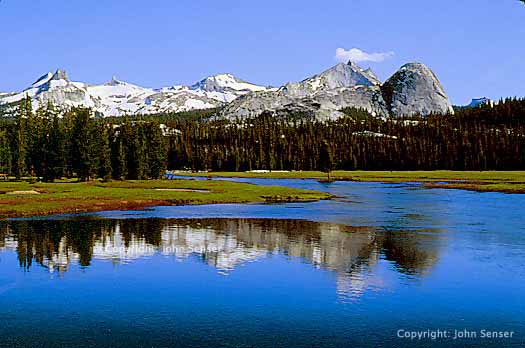 |
Once in his life a man ought to concentrate his mind upon the remembered earth. He ought to give himself up to a particular landscape in his experience; to look at it from as many angles as he can, to wonder upon it, to dwell upon it.
He ought to imagine that he touches it with his hands at every season and listens to the sounds that are made upon it.
He ought to imagine the creatures there and all the faintest motions of the wind. He ought to recollect the glare of the moon and the colors of the dawn and dusk.
- N. Scott Momaday
Momaday sets a high standard, but a worthy goal. The mere pursuit is a joy. In starting Sierra Nature Notes, I imagined that our readers would be from cities and suburbs and able only occasionally to break away from their jobs to visit the National Parks and forests of the Sierra. Perhaps, while staring at a computer terminal, they remember a place they'd visited - a clear alpine stream - and want to stay in contact with that small still place of memory, to learn more about the creatures there and relive the sounds of the wind.
In the 1920s and continuing into the mid-60s, the Yosemite Association published Yosemite Nature Notes, which was sent to park visitors who, after they returned home, still wanted to keep informed about the natural history of Yosemite and the Sierra. Not an intimidating peer-review scientific journal, contributors to Yosemite Nature Notes were nonetheless often leading scientists and historians doing work in Yosemite. The goal was to bring their discoveries and observations, often otherwise hidden away in journals, to the public. That is the hope of our electronic revival: Sierra Nature Notes.
Although Momaday's path emphasizes the experiential, I would argue that knowing a place includes knowing how what we call the landscape came to be—to visualize the relationships between rock and river and meadows and bears. From such knowledge we can slowly gain an understanding of the extraordinary web of relationships that make up the Sierra Nevada mountains.
The last decade has seen a huge increase in the amount of research being done throughout the Sierra. There has recently been an almost panicked realization by both land management agencies and the scientific community that, in spite of the protection of National Parks and Forests, a number of species are declining for unknown reasons.The Foothill Yellow-legged frog disappeared from most of its range before anyone was aware of it. The Mountain Yellow-legged frog's decline may have been caught in time, but only because researchers and land managers are reacting quickly. Much of this research effort is to not only search for causes, but to quickly establish a baseline of what's there now so that future problems can be more quickly noted and solutions found.
The goal of Sierra Nature Notes is to bring you news of these discoveries, perils and hope for the future. Thank you for joining us.
You can go to About Our New Site for more information.
Thank you,
George Durkee
Editor
Sierra Nature Notes
23807 Quaker Ln
Twain Harte, CA 95383
Question and comment form
Our Founder Questions? Go to About Our New Site |
Masthead
Photo from: |